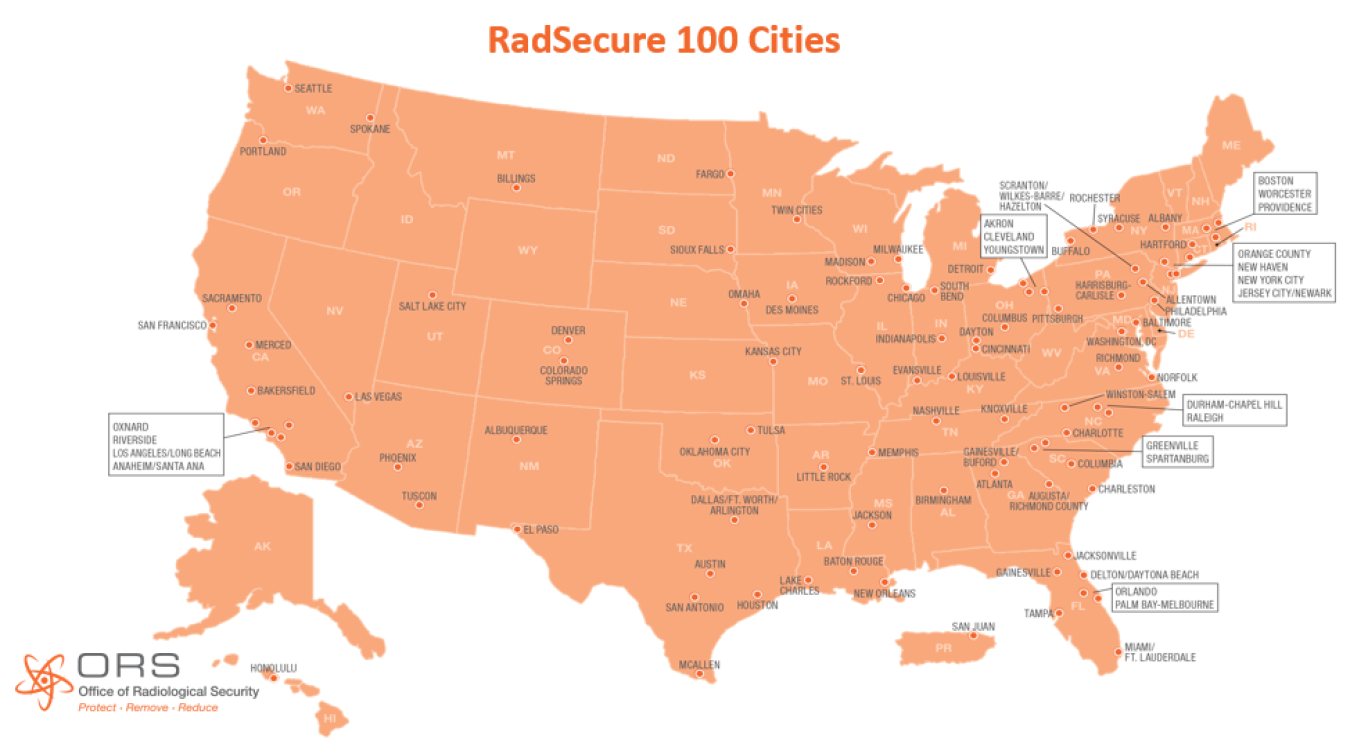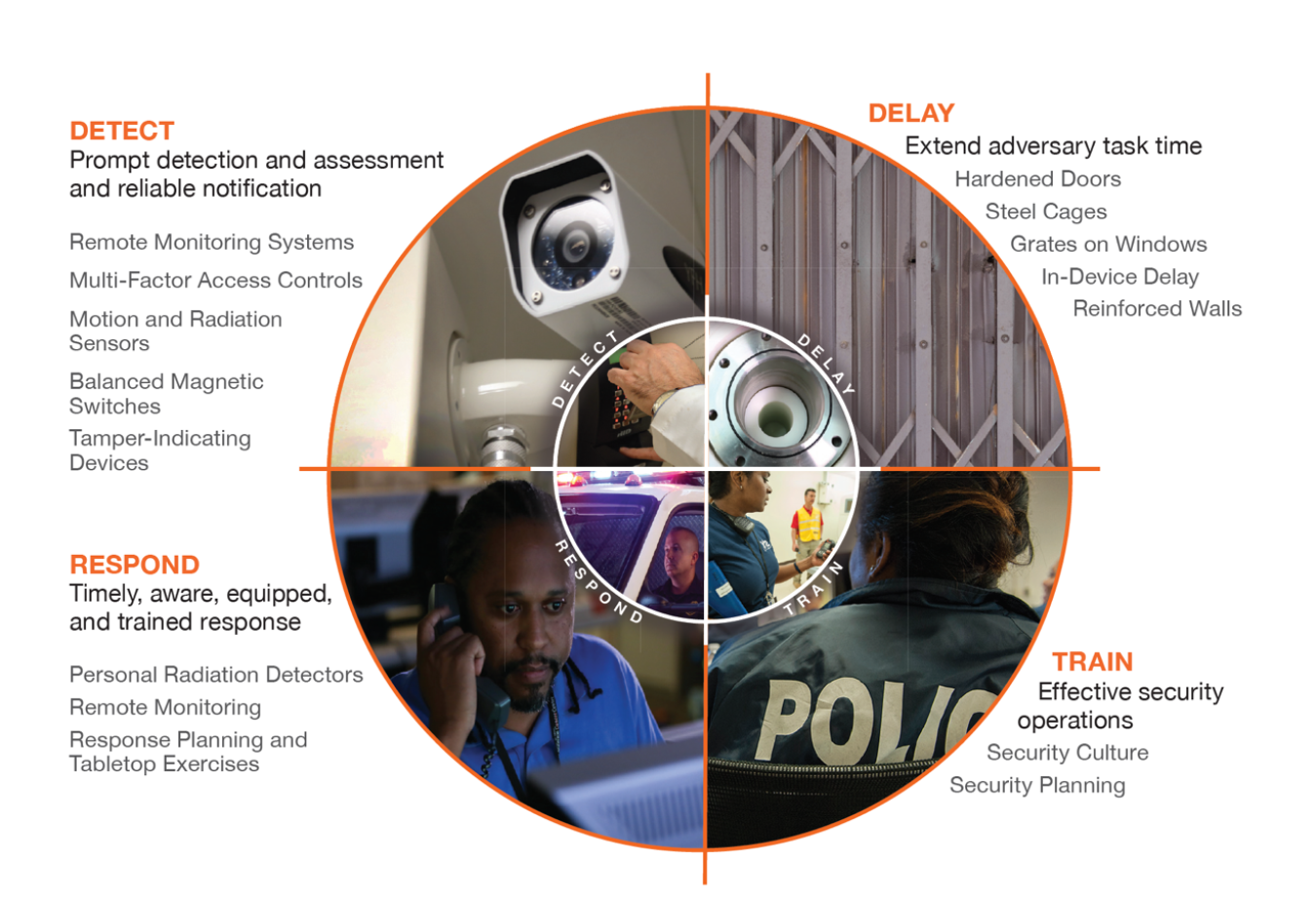The Office of Radiological Security (ORS) works with government, law enforcement, and businesses across the globe to protect radioactive sources used for medical, research, and commercial purposes; remove and dispose of disused radioactive sources; and reduce the global reliance on high activity radioactive sources through the promotion of viable non-radioisotopic alternative technologies.
Radioactive sources play an important role in commercial, medical, and research applications.
However, if a high-activity radioactive source falls into the wrong hands, it could be used for a radiological dispersal device (“dirty bomb”) or in other acts of terrorism. ORS works with governments, first responders, businesses, hospitals, and industries across the globe to provide users of radiological materials with world class security technologies, expertise, training, source recovery, and alternative replacement strategies. ORS focuses its resources on the security of widely used, high-activity sources including cesium-137, cobalt-60, americium-241, and iridium-192.
The program employs three strategies to accomplish its mission: 1) protect radioactive sources used in vital medical, research, and commercial applications; 2) remove and dispose of disused radioactive sources; and 3) reduce the global reliance on high activity radioactive sources by promoting the adoption and development of non-radioisotopic alternative technologies. Learn more about ORS's Reduce mission.
- Protect: ORS works with organizations to evaluate partners’ existing security systems, and provide protection upgrades, guidance, and training to enhance the security of high-activity radioactive sources. ORS collaborates with partner organizations worldwide on sustainable security, including implementation of regulatory development, security planning and training, transportation security, This was an empty link: response response planning and training, and the strengthening of inspection and enforcement regimes.
- Remove: ORS works with users of radioactive sources to assist with the proper removal of disused radioactive sources, helping to eliminate excess, unwanted, abandoned, or orphaned radioactive sealed sources that pose a threat to security, public health, and safety. In the United States, ORS manages the Off-Site Source Recovery Project, which recovers and disposes of disused radioactive sealed sources. Internationally, ORS collaborates with partners to repatriate U.S. origin radioactive sealed sources and supports partner country efforts to remove disused sources to a secure location. To learn more about NNSA’s recovery of disused and unwanted radioactive sources or to register your devices with NNSA for recovery, please click here.
- Reduce: ORS works to reduce the global reliance on high-activity radioactive sources by promoting the development and adoption of non-radioisotopic alternative technologies where technically, operationally, and economically feasible. As technologies mature, more alternatives are available for common applications that currently use high-activity radioactive sources. By promoting long-term, permanent risk reduction through voluntary transition to alternatives that eliminate the need for in-depth security and infrastructure modifications and end-of-life management concerns, ORS enables facilities across the world to reduce the long-term costs of operation. ORS works with multiple stakeholders including federal and state governments, industry, healthcare professionals, researchers, and manufacturers – to identify opportunities for information-sharing, education, research and development, and access to replacement incentive programs. One replacement incentive program is the ORS Cesium Irradiator Replacement Project (CIRP), which directly supports the replacement of U.S. cesium irradiators with alternative technologies. Learn more about CIRP at this link.
Since its inception, ORS and its predecessor organizations have:
- Partnered with more than 1,700 sites in over 80 countries and all 50 U.S. states, plus Puerto Rico, to strengthen radiological security;
- Enhanced security at more than 2,300 buildings containing radiological material; including the installation of kits used to delay access on more than 659 radioactive source devices in the United States in collaboration with device manufacturers;
- Replaced more than 150 cesium or cobalt irradiators in the U.S. and 18 globally with alternative technologies. On track to meet the Congressional goal of replacing all U.S. cesium blood irradiators by the end of 2027 through the voluntary Cesium Irradiator Replacement Project;
- Since its creation in 2015, 46 countries and 10 observing organizations have participated in the Ad Hoc Working Group. The Ad Hoc Working Group was created to exchange views and ideas on the use and consideration of alternatives to high-activity sealed radioactive sources;
- Assisted with the removal of nearly 500 radioisotope thermoelectric generators worldwide, and deployed over 220 alternate power supplies, such as solar-powered systems;
- Conducted alarm response training, both in person and virtually, at the Y-12 National Security Complex. ART is specifically tailored to ORS partner sites and local responders who support protection of those sites. Since inception more than 7,100 participants from all 50 states have participated in this training;
- Assisted 17 major U.S. Cities in establishing their own Radiological Security Awareness and Response training programs to provide law enforcement personnel with tailored training programs and products for their jurisdiction. To learn more about this specialized RSAR training, click here.

Is Your City a RadSecure 100 City?
RadSecure 100 Initiative focuses on enhancing radiological security in 100 metropolitan areas throughout the U.S. The initiative prioritizes permanent risk reduction, enhanced security measures, and cooperation with local law enforcement to prevent an act of radiological terrorism.
ORS is securing our cities against acts of radiological terrorism, which requires the full support of, and collaboration with, a wide range of partners including businesses, law enforcement, city and state leaders, as well as federal agencies and other organizations.
Targeted Strategies to Secure Our Major Cities
- Permanent Risk Reduction Where possible, replace radiological devices with alternative technologies that do not require a radioactive source, removing any sources that are no longer needed.
- Security Enhancements Advance the security of mobile sources and radiological sites with the highest priority materials, including cesium-137, cobalt-60, americium-241, and iridium-192.
- Response Integration Integrate local law enforcement into planning and training to respond to a potential radiological theft.

For more information on RadSecure100 and ORS, contact: ORSinfo@nnsa.doe.gov.
An introduction to the RadSecure 100 initiative.NNSA

